Hi Everyone, I recently re-registered and have the following question:
in my 55 yr. old Cape, the floor in one room has noticable bounce to it, the house is of masonry construction 4″ block with 4″ brick and 8″ block at the sill and below, with 2″ x 10″ @ 16 “oc joists (actual 1½ x 9¼) with a 13′ span. one end lies on the central girder, the other lies directly on the CMU wall. there is traditional wood bridging at centerspan. there is no facility to sister joists since the wall end is completely buried in masonry, I have found no indication of insect damage or soft landing at the CMU end. the joists have no significant splits or penetrations to weaken them.
will installation of solid 2 x 8 bridging in 2 locations @ 1/3 span, screwed into the joists strengthen the floor assembly? tying each joist to each other for strength?
I’d rather not add an additional supporting girder below the joists.
any other ideas are appreciated,
Thanks for your reply.
Chris
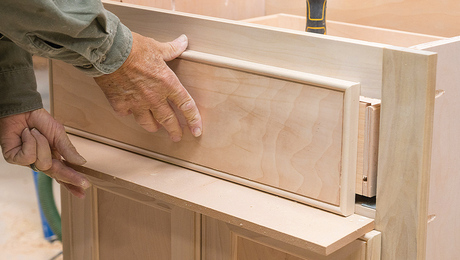

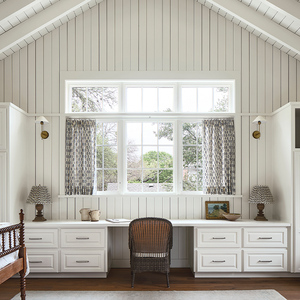
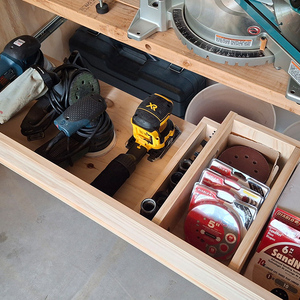
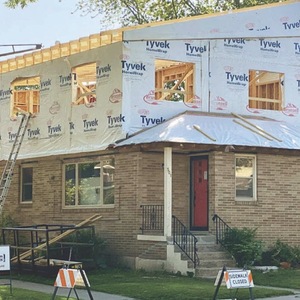
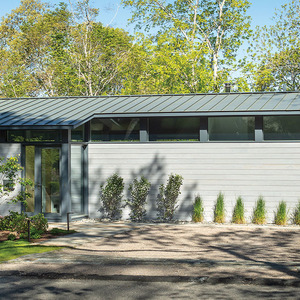













Replies
I'm surprised you're having trouble with 2X10s at a 13' span. That's well within what I'm comfortable with.
Two things come to mind. First - are you SURE they're 2X10s? I would have expected 2X8s on something that age around here.
Second - What exactly is the "central girder" you mention? (size, post spacing, etc.) An undersized beam can contribute to floor vibration.
I doubt solid blocking would do much of anything but create a place for queaks to occur.
>> there is no facility to sister joists since the wall end is completely buried in masonry << could you bolt inverted angle iron to the massonary and use that as end support ..
Oh boy! Can I , Can I..finally expouse the benefits of a truss?
See if he takes a 2x3 and spans the distance perp to the run of joists in the center..and then takes a 2x4 on edge attached at the end near the fixed point ( cement wall) and then, jacks the other end up and attached that now bowed 2x4 to the other end, (glue and fastener schedule TBD, onsite)..that is a bowstring truss.
By creating a flex in the 2x4 around the 2x3 you create lift and stiffness...I did it, and it works..screw all the connections and also the calculations, it works. Period. Spheramid Enterprises Architectural Woodworks
"I don't think it's funny no more" Nick Lowe.
"...screw all the connections and also the calculations..."
Naw - I don't work that way. I don't tell anyone something will work unless I have something to back it up with.
Your solution doesn't meet that criteria. Its's just guesswork.
Ambiguous headline: LOCAL HIGH SCHOOL DROP OUT CUT IN HALF
yes, they are 'nominal' 2 x10's in that they measure out to 1½ x 9¼.
the girder is made of (3) 2 x 8's, first span is 6' 8", next is 7' 8"
strangley enough, the bounce happens to joists that are adjacent to a lally column on the girder
from observations, the bouncing is in the joist, not the girder
the affected joists are #3 & #4 from the parallel bsmt wall, or 4' to 5½' away, nearly the center of the room.
I sorry to hear that tying all joists together as a unit will not help.
yes, I could create a ledger to sister joists to if necessary.
any other ideas?
I can attest and argue just like rest of us..it does work. Do the math, the compression of the bow will exceed the design value of the span on the joist,,,,modulus of elasticity, lika a guitar stings compression on the nut and bridge..or..like a suspension bridge for that matter.
A cable would do the same thing in lieu of the 2x4, under proper tension..c'mon you gotta know tensile vs. compression in your biz, and how to achieve a self supporting arch? The romans perfected that stratagy in a very simple terms to create the aqua ducts, the force of the load was transferred to the sides, now turn that upside down, same thing.
The flying buttress's were added to support the sidewalls from undue flexes, not loads. Spheramid Enterprises Architectural Woodworks
"I don't think it's funny no more" Nick Lowe.
I understand that you think your idea will work. And you could be right. (Although I'm very skeptical)I take giving structural advice very seriously. I won't tell someone that something WILL work unless I'm certain. I like to think I've gained some respect for sticking to that principle. (Other opinions may vary greatly, of course)Before I give out advice I either have experience specific to the situation, or rely on another proven source of information. Since your idea is merely speculation with nothing to back it up, I can't go along with it. Come up with some numbers, experience, or even a solid plan and I'm willing to think about it. You have no idea how much force will be in the members, or how to connect them to resist that force. You're just flying by the seat of your pants.So nothing personal, but I'm sticking to my guns on this one.
Stamp out crime - abolish the IRS.
Ok Ron..I agree with your views.
See Kidder and Nolan's HAndbook for architects and Builders..I don't have a pagination # handy..but in it you will find a detailed theory and factual evidence that it is not only plausible, it is historically accepted.
As far as MY exp? YES, I did incorporate that very same concept in a circa 1710 farm house...it had 2x8 nom on 30'' centers spannig 16'..I used a 2x3 midspan and swaled the strong backs with 3" #12 screws in a pattern like a chevron, and added osi adhesive ( before PL premium was known to me)...I jacked each bow into place and clamped and repeated the glu/scru process.
I swear to you, that floor which was "average" load, never again had an issue.
You have to understand that I didn't specifically call out and tell this poster that it was the only way or the best way, just A way to resolve a situ that occurs repeatedly and is often mishandled.
Just because you can't see it in yer mind, don't mean I am wrong or it is not plausible, a reverse ogee is so common, it defies explaining..so why not argue with that?
Lemme get my book out and find ya the #'s you desire, cuz I love ya. Spheramid Enterprises Architectural Woodworks
"I don't think it's funny no more" Nick Lowe.
Sounds like a pretty interesting idea. Having a bit of trouble totally picturing what you are recommending though... Are you saying that each 2x4 would have around a 5" bow in it? That's a lot...
nope..a "bow" to be the 2x3 or what ever on the FLAT, so not to exceed 1.5" over a given chord length of not to exceed 16'
You can actually just install a block on the bottom of the joist an ince point five thick at mid span.....attach the 2x4 along the side of the joist at one end, traverse the length, and cross uner the block and attach it at the other end under liftage force...where is the pressure gonna be? Theoretically at the bearing point of the keystone block...
Too simple to believe.
Like I said, bridges use the exact technology, as is a lot of prestressed concrete. Spheramid Enterprises Architectural Woodworks
"I don't think it's funny no more" Nick Lowe.
I think your idea would work (obviously it has worked for you too). I saw something similar in a magazine (maybe even FHB?) once. I think I also saw a similar idea that used metal strapping. That's what I did in my basement and it helped some--not as much as I wanted, but I only did it in one spot because the china cabinet upstairs shook and all the dishes clanged whenever I walked across the dining room floor. (Tried walking across the ceiling, but kept falling off.)
Simple physics ..every action has an equal an opposite reaction, mess with compression by adding tension they can cancel out to a harmonic balance. Same holds true with many aspects of lutherie. Spheramid Enterprises Architectural Woodworks
"I don't think it's funny no more" Nick Lowe.
Sphere,
I have no doubt what you propose will work, I understand the concept perfectly. However, I do have concerns for the longevity of the solution with all the mechanical fastenings involved in addition to the mechanics of the glue line, particularly when built in the air. I have infinite confidence in doing it right, but a simpler solution should exist.
If I were building this new, and I had to limit joist depth, then your proposal is an elegant solution that can be control built in a jig on the bench.
since I've only been in this house 6 yrs. I have no way of knowing whether this is an old or new problem, it is at minimum a 6 yr old problem.
it may be that indeed I have bad lumber here. any tips on how to test it?
any other ideas?
If the 2x4 is on the side of the joist, I expect you mean the bottom of the 2x4 is basically flush with the bottom of the joist. Once the 2x4 is dropped underneath the 2x3 piece in the middle, and then lifted back up at the other end of the joist so that the bottom of the 2x4 is again flush with the bottom of the joist, that will be 5 inches of "bow" or deflection of the 2x4 piece. Is that the correct understanding?
The force needed to cause the 2x4 to deflect 5 inches over approximately 16 feet would be 200# (depending on the modulus of elasticity). Bending in a simple span 16 feet with 200# load at midspan is 800 ft.-lbs. Bending stress on the 2x4 would be 3134psi. Probably twice the allowable capacity of a common 2x4. Of course, I don't think 16 foot 2x4's are too common. Additionally over a shorted span, a greater force woudl be needed to cause the deflection described.
Another post sites the use of split ring fasteners. This type of fastener can be difficult to install but provides a significant load capacity, more substantial than a few bolts or nails would. It might exceed the capacity of a 2x4 though.
If such a reinforcement was installed I think it would likely stiffen the joist by providing alot of initial resistance to deflection. By doing so it would make the joist "feel" more solid. I suspect that such a repair would perform satisfactorily. I question whether or not this will actually increase the load capacity of the joist that can be justified by design. That is to say, if the components are not behaving within their safe (code limited) load capacity or stress, it is problematic.
You missed where Sphere reiterated that the 2x3 is flat, so the 2x4 only deflects 1-1/2". I don't see where you would get a 5" bow even if the 2x3 (nominal) were on edge--it would only be 2-1/2". Are you doubling the number for some mathmatical reason not apparent to me? Anyway, it's been pretty well beaten to death. Sistering seeems to be the popular answer.
Edit: I had it pointed out to me that Sphere mentioned putting the 2x4 along side the joist, so the deflection would be more like 5". I stand corrected and apologize for my arrogance! You are right! Also, the stress amy be more than a 2x4 can handle and it may lose it's elasticity over time and stop resisting the force. [Sort of like Darth Vader?] [Now I'll probably get an email from him!!] ;-)
Edited 10/27/2005 7:24 am ET by Danno
Edited 10/28/2005 7:49 am ET by Danno
! agree, since tying the floor system together won't do the trick, sistering appears to be the only logical choice.
Thanks to you all for your input!
"Just because you can't see it in yer mind, don't mean I am wrong or it is not plausible..."
I never said I couldn't see it in my mind, or that it wasn't plausible. Just that I wanted evidence that something would work before I went along with it.
"See Kidder and Nolan's HAndbook for architects and Builders..."
That's the kind of stuff that interests me - Although I don't know where I'd find a copy of the book.
I don't have a license to kill. I have a learner's permit.
Aboutthe book, yeah, mine is SOOO old the pages are gold on the edges..as to the OP'ster..the joint is detailed by using a ring connector, not too easily done by a novice...basically drill a circle and a donut of steel is sandwiched in each mating dado..
Followed witha thru bolt, it is almost indestrucable. Spheramid Enterprises Architectural Woodworks
"I don't think it's funny no more" Nick Lowe.
A few thoughts... (but no solution :-) First, bridging won't help. Strapping under them won't help much either - in my expierence. Second, maybe you have a few bad joists... it happens. Like when you are going through a stack of 2x10s and all of a suden you pick one up that weighs literally 1/2 of the others, or maybe you notice another one is about as stiff as a rubber band.
Edited 10/26/2005 7:43 pm ET by Matt
Yes, you can sister another joist onto the originals. The fact that one end is embedded in concrete is irrelevant. Butt the sister to the concrete (Hmmm, think about that phrase for a second...) & fasten as you would in any other sistering situation and you're good to go.
You're not trying to increase load capacity, so how the additional joist bears on its end is of no consequnce as long as it is fastened securely to the original. You're just looking for stiffness & viagra won't work in this case.
Good luck.
You beat me to it Nanny. Sister a 2x12 to the joists, and make them as long as possible. They do not need to have bearing on the ends, but it would be nice. The existing 2x10's are strong enough, but thay have too much deflection. The added 2x12 should take care of that.
"When asked if you can do something, tell'em "Why certainly I can", then get busy and find a way to do it." T. Roosevelt